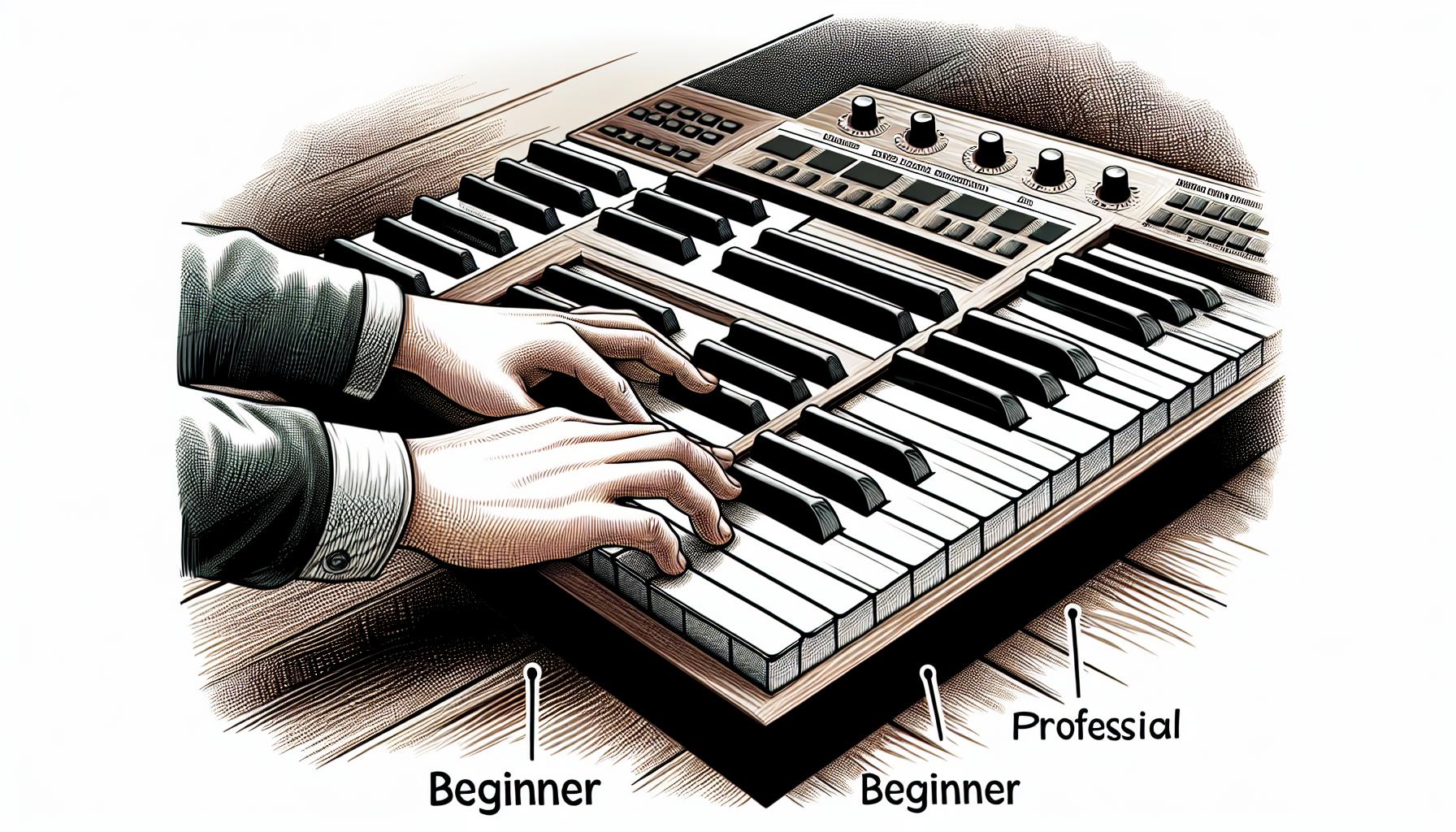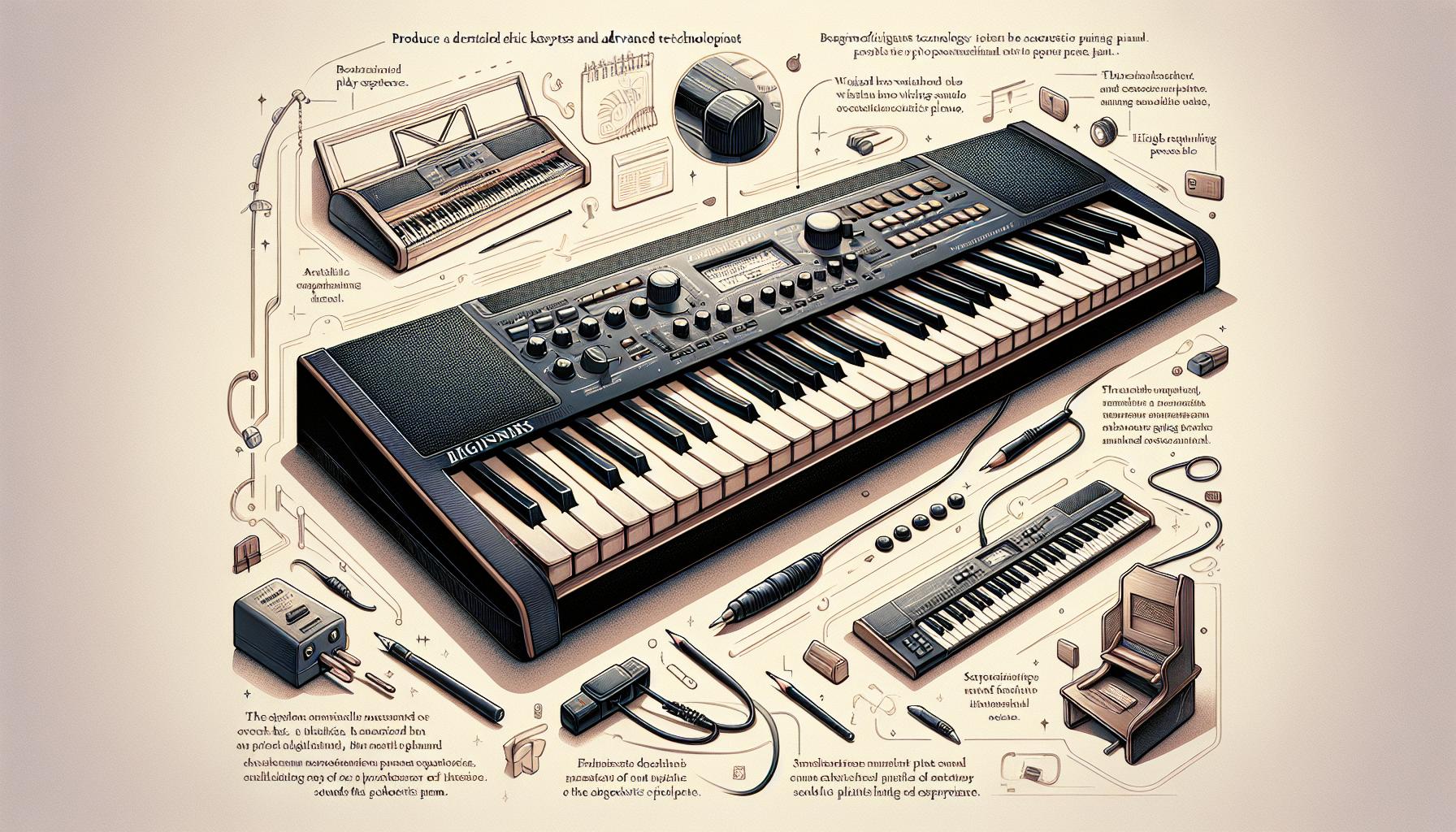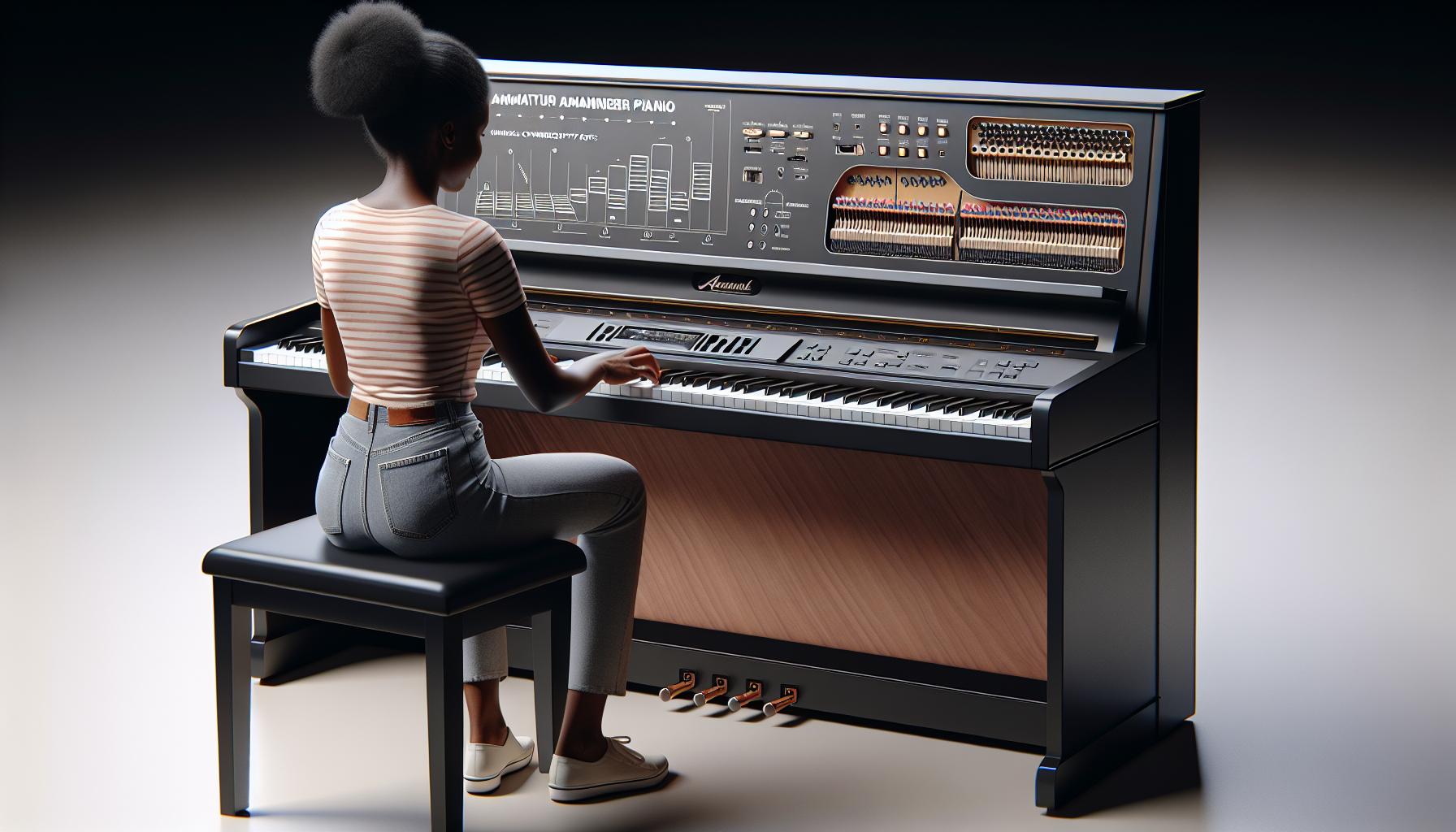For beginners stepping into the world of music, finding the right keyboard can feel like searching for a needle in a haystack. They're on the lookout for something that doesn't just fit their budget but also mimics the rich, resonant sound of a grand piano. It's a tall order, but not impossible.
Enter the realm of keyboards with realistic piano sounds, a game-changer for novices eager to learn. These instruments promise the best of both worlds: the affordability and convenience of a keyboard, coupled with the sonic beauty of a traditional piano. It's like having a concert hall at your fingertips, without breaking the bank.
Understanding the Importance of Realistic Piano Sound
When beginners embark on their musical journey, the essence of the sound produced by their instrument becomes a cornerstone of their learning experience. Realistic piano sound in keyboards isn't just a feature; it's a bridge connecting the learner to the rich history and emotional depth of piano music. By closely mimicking the acoustic grand piano, these keyboards provide an immersive experience that enhances both practice and performance.
One might wonder why the quality of sound matters so much, especially for beginners. The answer lies in the link between auditory feedback and musical development. As students press the keys, the immediate sound that echoes shapes their understanding of pitch, tone, and dynamics. When the keyboard produces sounds that are indistinguishable from a grand piano, learners are better equipped to judge their performance and make necessary adjustments. This real-time feedback is critical in developing a keen ear for music, a skill that is invaluable for any musician.
Moreover, keyboards with realistic piano sounds often include weighted keys, which replicate the resistance and touch of acoustic piano keys. This feature is essential for building finger strength and dexterity, as well as for learning the nuanced control needed to play expressively. The tactile feedback combined with high-quality sound helps in cultivating a deep connection with the instrument, encouraging continued practice and exploration.
| Factor | Impact on Learner |
|---|---|
| Sound Quality | Enhances engagement and learning satisfaction |
| Tactile Feedback | Improves technique and expressiveness |
| Repertoire adaptability | Broadens the range of music that can be explored |
The journey of learning music can be laden with challenges, yet the rewarding feeling of mastering a piece on an instrument that sounds and feels like the real thing is unparalleled. It ignites a sense of accomplishment and propels learners to set and achieve higher goals. This level of motivation is essential, especially in the early stages of learning, where progress might seem slow and painstaking at times.
In addition, the versatility of a keyboard that offers a realistic piano sound is an asset for a beginner. It allows for an exploration of a wider repertoire, from classical to contemporary genres, without the limitation of an instrument that might not do justice to the nuances of the piece being played. This adaptability not only nurtures a broad musical taste but also keeps the learning process exciting and enriching.
Features to Look for in Keyboards with Realistic Piano Sounds

When embarking on the journey of learning the piano, the quest for the right keyboard can seem daunting to beginners. However, understanding the key features that contribute to a realistic piano sound can make this search much simpler and more fruitful. Here are some crucial aspects beginners should consider.
Weighted Keys
One of the most significant features influencing the realism of a piano sound is the presence of weighted keys. Weighted keys mimic the heavy feel of acoustic piano keys, providing the tactile feedback necessary for learning proper finger technique and dynamics.
Key Fact: Most acoustic pianos have keys that require a certain amount of pressure to produce sound, which is essential for developing sensitivity and expression in playing.
Touch Sensitivity
Touch sensitivity, or velocity sensitivity, allows the keyboard to respond to the force with which a key is pressed, producing louder sounds with harder presses and softer sounds with gentle presses. This feature is paramount as it enables beginners to experiment and understand the importance of touch in expressing emotions through music.
Polyphony
Polyphony refers to the number of notes a keyboard can produce at one time. As beginners progress, they start playing more complex pieces that require multiple notes to be held simultaneously, making high polyphony a valuable feature.
| Polyphony Level | Suitable For |
|---|---|
| 32 | Absolute Beginners |
| 64 | Intermediate Players |
| 128+ | Advanced Players and Learning |
Quality of Sound Samples
The richness and authenticity of the piano sound in a keyboard largely depend on the quality of its sound samples. High-quality samples provide a more immersive and enjoyable playing experience, encouraging learners to spend more time practicing.
Top Tip: Look for keyboards that offer samples recorded from real acoustic pianos.
Connectivity Options
Modern keyboards come with various connectivity options such as MIDI, USB, and Bluetooth. These features offer beginners the flexibility to connect their keyboards with teaching apps or recording software, expanding their learning resources and potential for creativity.
Built-in Learning Tools
Many keyboards now include built-in metronomes, record functions, and sometimes even light-up keys to aid in learning. These tools can be incredibly beneficial for beginners, offering immediate feedback and enabling self-guided learning outside of lessons.
Top 5 Keyboards with Realistic Piano Sound for Beginners

When beginners embark on their musical journey, having a keyboard that closely mirrors the acoustic piano experience is crucial. It not only aids in developing the correct technique but also enriches the learning process. Here are the top 5 keyboards that offer a realistic piano sound suitable for beginners.
Yamaha P-45 Digital Piano
The Yamaha P-45 stands out for its simplicity and the quality it offers. It's an excellent choice for beginners for several reasons:
- Weighted keys simulate the feel of an acoustic piano, offering a genuine playing experience.
- 64-note polyphony ensures that notes are not cut off early when playing complex pieces.
- The Advanced Wave Memory (AWM) sampling uses digital technology to record the sound of an acoustic piano. It creates a deeper, richer, and more spacious sound.
Casio Privia PX-160
The Casio Privia PX-160 is known for its impressive features at an affordable price point:
- The Tri-Sensor Scaled Hammer Action II keyboard has an exceptional feel, mimicking the dynamics of an acoustic piano.
- It boast an impressive 128-note polyphony, allowing for the performance of complex compositions without note dropouts.
- Its AiR Sound Source provides highly accurate grand piano sounds with seamless dynamics for a remarkably expressive and powerful performance.
Roland FP-10
Roland's FP-10 is an entry-level keyboard that doesn't skimp on quality:
- PHA-4 Standard keyboard provides sensitivity and a realistic touch response.
- With SuperNATURAL Piano technology, the sound engine delivers authentic piano sounds.
- It’s also equipped with Bluetooth MIDI, which expands learning resources and possibilities for beginners.
Korg B1 Digital Piano
Korg's B1 is a favorite among beginners for its focus on the essentials:
- Natural Weighted Hammer action mimics the feel of real piano keys, enhancing technique from the start.
- It offers 120-note polyphony, catering to the needs of most beginner pieces.
- MFB (Motional Feedback) technology ensures the audio output is pristine, providing a very clean sound.
- It features 88 full-sized hammer-action keys with adjustable touch response.
Tips for Choosing the Right Keyboard

When embarking on the journey of choosing a keyboard with a realistic piano sound, especially for beginners, it's essential to keep several critical factors in mind. Navigating the sea of options can be daunting, but focusing on a few key aspects will make the selection process smoother and ensure the purchase meets the player's needs.
Firstly, consider the key action and weight. For a truly realistic piano experience, the keyboard should mimic the resistance felt when pressing the keys of an acoustic piano. Look for terms like "weighted" or "hammer action" keys. These features contribute greatly to the development of proper finger technique and strength, which are crucial for beginners.
Another vital aspect is the quality of the sound. High-quality sound samples and a good polyphony count are indicators of how realistic and expressive the keyboard will sound. Polyphony refers to the maximum number of notes a keyboard can produce at one time. A higher count allows for more complex and nuanced playing. Here's a quick summary of the recommended polyphony count based on the discussed models:
| Keyboard Model | Recommended Polyphony Count |
|---|---|
| Yamaha P-45 | 64 |
| Casio Privia PX-160 | 128 |
| Roland FP-10 | Not specified |
| Korg B1 | 120 |
Touch sensitivity is another feature that cannot be overlooked. This allows the keyboard to respond to the force with which the keys are pressed, producing louder or softer sounds accordingly, thus offering a dynamic range that mimics an acoustic piano.
Connectivity options are also worth considering. Features like USB and MIDI ports allow the keyboard to connect to computers and other devices, which can be particularly useful for beginners eager to use educational software or record their playing.
Size and portability might influence the decision, especially for those with limited space or those who plan to travel with their instrument. While full-sized keyboards with 88 keys offer the best piano-like experience, smaller models might be more practical in certain situations.
Lastly, don't overlook the value of extra features such as built-in metronomes, lesson modes, and a variety of instrument sounds. While not directly related to the natural piano sound, these features can greatly enhance the learning experience and keep the beginner engaged.
Conclusion
Choosing the right keyboard with a realistic piano sound is a significant step for beginners on their musical journey. By focusing on key action, sound quality, polyphony, touch sensitivity, and connectivity, learners can find an instrument that not only mimics the feel of an acoustic piano but also supports their growth as musicians. With models like the Yamaha P-45, Casio Privia PX-160, Roland FP-10, and Korg B1 offering a range of features tailored to novices, there's a perfect keyboard out there for everyone. Remember, the goal is to enjoy the learning process while developing your skills, so pick a keyboard that feels right for you and let the music begin.
Harlan Kilstein began playing piano during covid with no piano background at all. He taught himself how to play learning what to do and what not to do.
Today he's an advanced intermediate player and can help you grow in your skills because he learned all this on his own.







